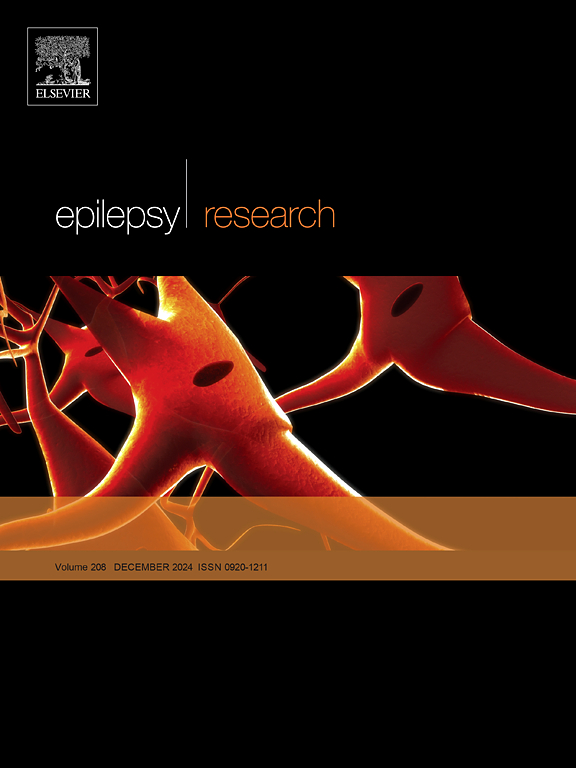Seizure and cognitive outcomes of cortical long bursting responsive neurostimulation in intractable focal epilepsy
IF 2
4区 医学
Q3 CLINICAL NEUROLOGY
引用次数: 0
Abstract
Responsive Neurostimulation (RNS) is an established therapy for drug-resistant epilepsies (DRE), yet conventional high-frequency stimulation delivered in short bursts (SB; 100 ms) may fail to achieve significant seizure reduction. This retrospective study evaluated the efficacy of cortical high-frequency long-burst (LB; 5000 ms) RNS therapy in 13 DRE patients who experienced less than a 50 % reduction in seizures with SB therapy. After initiating LB therapy, 55 % of patients achieved a seizure reduction of more than 50 %, with a median follow-up of 13 months. Although the number of stimulation therapies delivered per day did not significantly differ between the SB and LB paradigms, the LB RNS delivered a substantially higher charge per hour (mean 18 mC/hr vs. 0.7 mC/hr) to the epileptogenic cortex. Importantly, despite the increased charge, no cognitive decline was observed, likely due to the precise timing of the stimulation in response to epileptiform activity. These findings suggest that LB RNS may be a viable alternative for patients who do not respond to conventional RNS therapy, offering improved seizure control without compromising cognitive function. However, the increased charge raises concerns about battery life, emphasizing the need for further research on different stimulation frequencies in LB RNS. This study highlights the potential of tailored stimulation paradigms to optimize outcomes in drug-resistant epilepsy.
顽固性局灶性癫痫皮质长爆反应性神经刺激的发作和认知结果
反应性神经刺激(RNS)是一种治疗耐药癫痫(DRE)的既定疗法,但传统的短脉冲高频刺激(SB;100 ms)可能无法显著减少癫痫发作。本回顾性研究评估了皮质高频长爆发(LB;5000 ms) RNS治疗13例DRE患者,经SB治疗癫痫发作减少小于50% %。在开始LB治疗后,55% %的患者癫痫发作减少超过50% %,中位随访时间为13个月。虽然每天刺激治疗的数量在SB和LB模式之间没有显着差异,但LB RNS每小时向致痫皮质传递的电荷要高得多(平均18 mC/hr对0.7 mC/hr)。重要的是,尽管电荷增加,但没有观察到认知能力下降,这可能是由于对癫痫样活动的刺激的精确时间。这些研究结果表明,LB RNS可能是对常规RNS治疗无反应的患者的可行选择,在不损害认知功能的情况下提供更好的癫痫控制。然而,充电的增加引起了对电池寿命的担忧,强调了对LB RNS中不同刺激频率的进一步研究的必要性。这项研究强调了量身定制的刺激模式在优化耐药癫痫治疗结果方面的潜力。
本文章由计算机程序翻译,如有差异,请以英文原文为准。
求助全文
约1分钟内获得全文
求助全文
来源期刊

Epilepsy Research
医学-临床神经学
CiteScore
0.10
自引率
4.50%
发文量
143
审稿时长
62 days
期刊介绍:
Epilepsy Research provides for publication of high quality articles in both basic and clinical epilepsy research, with a special emphasis on translational research that ultimately relates to epilepsy as a human condition. The journal is intended to provide a forum for reporting the best and most rigorous epilepsy research from all disciplines ranging from biophysics and molecular biology to epidemiological and psychosocial research. As such the journal will publish original papers relevant to epilepsy from any scientific discipline and also studies of a multidisciplinary nature. Clinical and experimental research papers adopting fresh conceptual approaches to the study of epilepsy and its treatment are encouraged. The overriding criteria for publication are novelty, significant clinical or experimental relevance, and interest to a multidisciplinary audience in the broad arena of epilepsy. Review articles focused on any topic of epilepsy research will also be considered, but only if they present an exceptionally clear synthesis of current knowledge and future directions of a research area, based on a critical assessment of the available data or on hypotheses that are likely to stimulate more critical thinking and further advances in an area of epilepsy research.
 求助内容:
求助内容: 应助结果提醒方式:
应助结果提醒方式:


